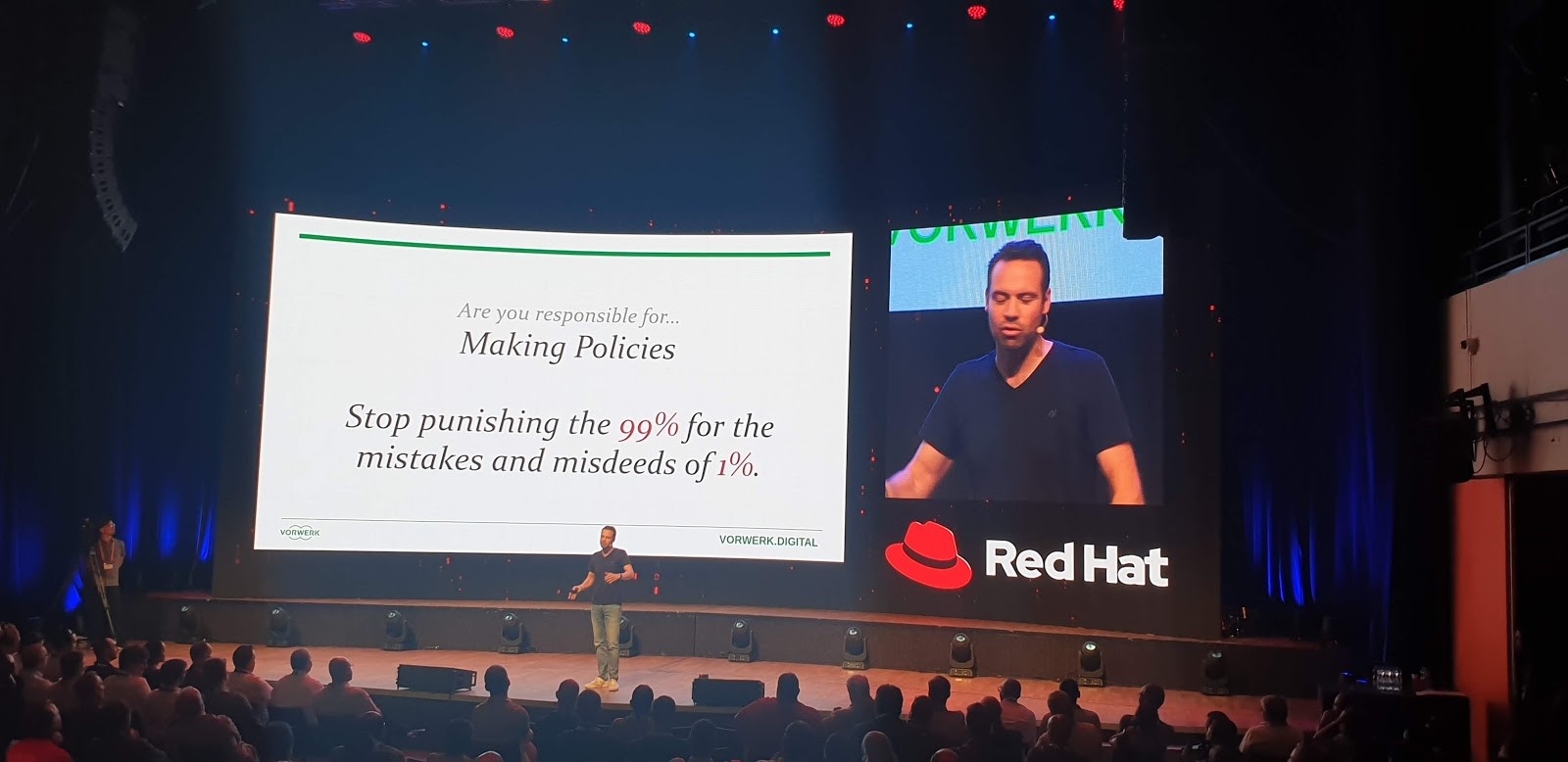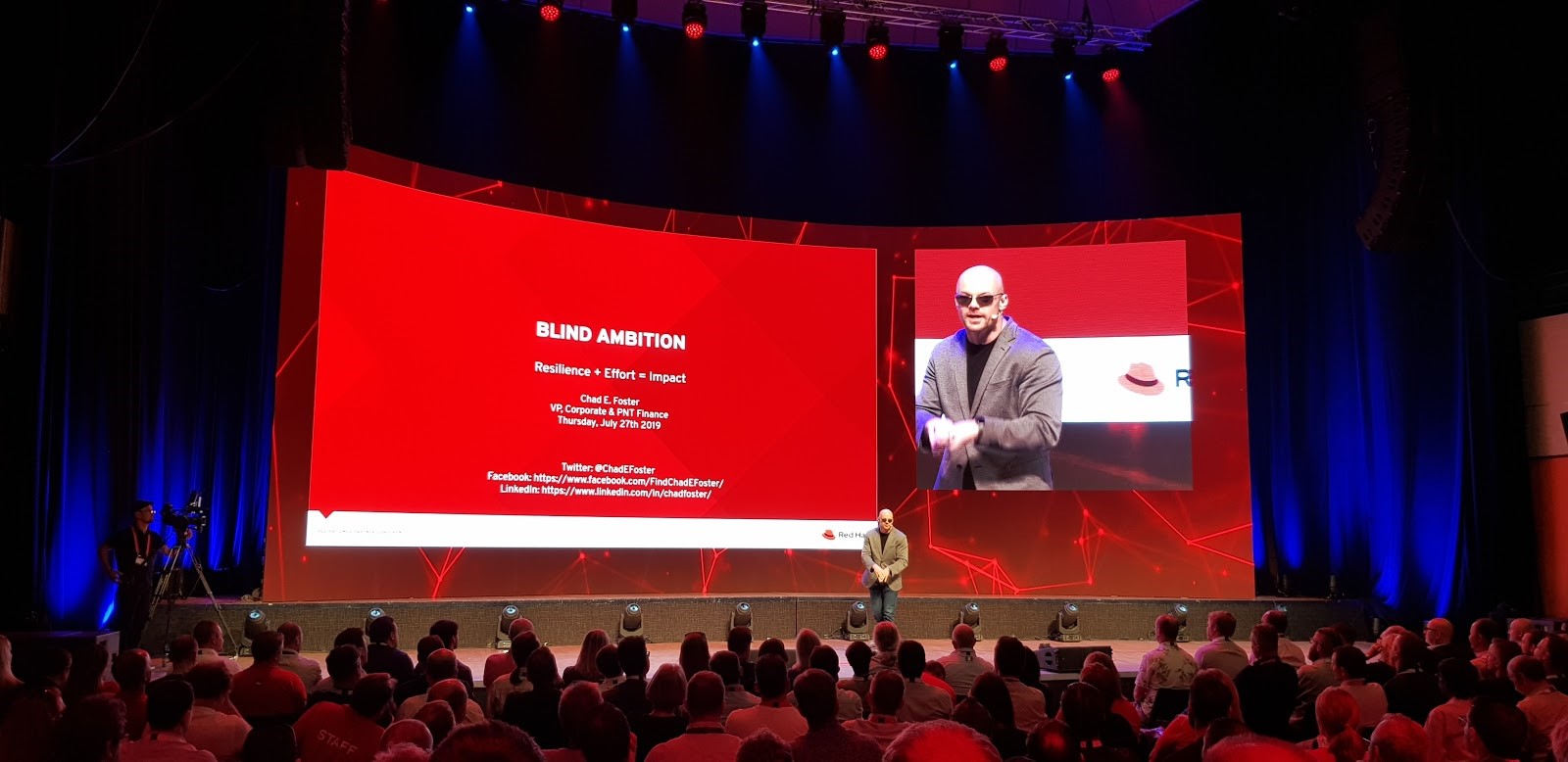Last week we visited Red Hat’s EMEA Partner Conference in Prague. In this blog-post we highlight the most special keynotes, workshops and other experiences from our attendance at the conference. So if you were not able to attend, or if you are simply looking to relive the most important takeaways, read on!
1) Keynote: Vorwerk Digital and the TM6
On the 26th of June at 5:35 PM the Forum Hall of the event was packed with attendants, all there for Vorwerk’s keynote on embracing digital as a core competitive advantage with their TM6 platform delivering growth and innovation, utilizing modern technology and agile methodology. Their keynote focused on the story of TM6 and how it was done. Vorwerk’s VP of Digital & Strategic Innovation, Julius Ganns, presented this keynote on stage.

For this project Vorwerk selected the Red Hat OpenShift Container Platform. Using Red Hat’s enterprise-grade Kubernetes container application platform, Vorwerk can consistently create, deploy, and manage applications across hybrid and multicloud infrastructures. Read more about this case study on right here.
2) Keynote: the Blind Ambition
On the next day at 5:00 PM the Forum Hall was completely full again for, in my opinion, the best keynote of the entire conference, called Blind Ambition. This keynote was all about perspective on life, but in a very humorous way and with great audience engagement.

The audience was continuously challenged to frame their perceptions on certain topics in order to reach their goals in a more effective way. One of my main takeaways is that a lack of eye-sight does not always mean a lack of vision. Be sure to check out one of Chad Foster’s older videos about this same subject below.
https://youtu.be/HcvyFD8rpDA
3) News and Updates from the Breakout Sessions
RHEL 8
- RHEL 8 will from now on only distribute the x64 version
- Leapp, is introduced as the new upgrade tool when you want to migrate from RHEL7 to 8. This tool will create a temporary ram-disk from which it will perform the actual upgrade.
- Performance has been improved on CPU disk and networking level by redesigning the networking.The improvement percentages in more detail:
– CPU 10%
– Disk io: 30%
– Networking side: 45%
OpenShift 4 is completely redesigned
They have eliminated Docker by using CRI-O. The installation of OpenShift 4 is fully Terraform based, and the upgrade procedure has become very easy. Usually you could easily make mistakes because of the 250+ variables which you could choose from in Ansible. This has been replaced through better UI by using the upgrade button in the admin console.
4) Other key topics from Red Hat’s EMEA Partner Conference
Next to the interesting keynotes and workshops, there were a lot of other interesting updates and sessions from Red Hat. Below you can find the top learning.
Kubernetes Operators
An Operator is a method of packaging, deploying and managing a Kubernetes-native application. A Kubernetes-native application is an application that is both deployed on Kubernetes and managed using the Kubernetes APIs and Kubectl tooling. Learn more about operators right here.
The UDICA Project
UDICA is an upstream project on which you set SElinux rules per container in a very simplified way. Originally you could set SElinux rules but that was only possible for all containers and not per container. As everyone knows, creating rules for SElinux can be a tough job. UDICA will make this easier and will auto-create rules and implement them in your kernel. In this way you can fine-grane security on container level. This is currently available in Fedora as an upstream project. Learn more about UDICA right here.
OCP 4
OCP 4 can be configured with different Identity providers, such as LDAP, GitHub, GitHub Enterprise, etc. The following OCP 4 upgrades were announced on the conference:
- Early upgrades can happen and full support will be provided for short upgrades, then critical support will be enabled to move from 4.1 onward.
- Minimum 2 years of maintenance support will be provided for customer confidence.
- Telemetry is optional, but in case it’s disabled, the customer will not be able to get technical insight of the cluster, as it’s used in the new way Red Hat Manages subscriptions.
- Universal base image: Red Hat enables the ability to provide a pre-built language image. This will be supported by 3 different tiers.
- Starting from OCP 4.2, a migration service will be provided. This service is based on the upstream project called Valero, which is going to make a snapshot on the OCP cluster and then start the upgrade.
- A migration strategy can be enabled from 3.11 to 4.x in quarter 3 or 4.
FUSE ONLINE = Agile Integration
Fuse brings integration capabilities like AMQ and 3SCALE for API Management. Usually AMQ and 3SCALE are called integration products, because they leverage methods and tools that allow the agile and effective integration of services, applications, APIs and data as a foundation for competitive advantage. The agile integration approach focuses on the API approach. All of this is meant to keep up with the pace of the fast evolving technologies.
More about the Red Hat EMEA Partner Conference
Unfortunately we were not able to clone ourselves, meaning we were not able to attend all sessions and workshops. Luckily for us, Red Hat did. So for more info check this dedicated red Hat web-page. If you have any questions, or want to learn more? Please contact us via our contact form or through the contact blocks below.
